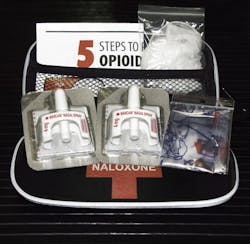Exposed: What Risks Do Police Face with Fentanyl Exposure?
Dr. Lewis Nelson began hearing the reports of police officers feeling ill following exposure to fentanyl in 2017.
Then came the videos: footage showing officers feeling dizzy after coming into contact with the powerful opioid. At least one video would capture an officer seeming to pass out apparently because of just touching fentanyl.In that recorded incident, an officer can be seen opening the back of an SUV when he’s warned about the presence of fentanyl.
This article appeared in the September issue of OFFICER Magazine. Click Here to view the digital edition. Click Here to subscribe to OFFICER Magazine.
In that recorded incident, an officer can be seen opening the back of an SUV when he’s warned about the presence of fentanyl. Soon, the officer drops to the ground, a reaction that puzzled Nelson, who has seen his share of cases of fentanyl poisoning as a New Jersey emergency room doctor.
“If I gave it to you, it wouldn’t do that to you,” Nelson, a past president of the American College of Medical Toxicology (ACMT) and professor and chair of the Department of Emergency Medicine at Rutgers University Medical School, tells OFFICER Magazine. “And then (the officer is) laying on the ground with his eyes open, breathing. And that’s just not what it looks like.”Dr. Andrew Stolbach had a similar reaction after watching the footage, as well. But he, like Nelson, didn’t think any of the officers who reported feeling ill because of fentanyl exposure were exaggerating or faking their symptoms. They were legitimately feeling distress; it’s the cause that was questioned.
“I haven’t seen a case where I thought somebody was intentionally making up symptoms for some malicious reason,” says Stolbach, a member of ACMT’s Board of Directors and an associate professor of Emergency Medicine at Johns Hopkins School of Medicine in Baltimore. “I think these people are really feeling symptoms and they’re really, really feeling these things. It’s just not as a result of this drug.”
Up to 100 times more powerful than morphine and 50 times more powerful than heroin, fentanyl is a prescription painkiller that has become a source of abuse, and drug dealers have been known to cut heroin and cocaine with it. The narcotic also has become one of the leading causes of overdoses in the country, especially among those who hadn’t known they were introducing it into their system.
Fentanyl’s potential lethality has led to an aggressive public information campaign about its dangers, leading to Narcan becoming a first aid kit staple. That fervor to protect the public, however, has led to misinformation being spread among first responders, and it could be a key factor in reports of fentanyl exposure sickness.
“We have been spending a lot of time trying to tone down some of the rhetoric that’s been out there about the risks, because there are a lot of unintended consequences to instilling fear into law enforcement and other first responders,” says Nelson.
Knowing the Risks to Minimize Them
As the opioid epidemic continued to escalate late last decade, law enforcement agencies began to see fentanyl popping up in greater quantities among drug seizures. In fact, crime labs saw the amount of fentanyl products they were testing triple from 2016 to 2019, according to the American Society of Evidence-Based Policing.
Because of the likelihood police and law enforcement officers could encounter fentanyl on the job, the DEA warned in 2016 that accidentally inhaling or touching the drug could lead to “adverse health effects, such as disorientation, coughing, sedation, respiratory distress or cardiac arrest … within minutes of exposure.” A few years later, the Centers for Disease Control issued a similar precaution in a video that has since been removed.
“I’ll tell you that if you gave me a pile of fentanyl right now in front of me, I would have absolutely no qualms touching it,” says Nelson. “I wouldn’t touch it and put it up my nose and eat a lot of it, but I am not concerned. There is even a video you’ll find online—as crazy as it is—of a of a pharmacist doing exactly that.”As more reports began cropping up of first responders becoming sick from apparent fentanyl exposure, Nelson, Stolbach and other ACMT members were charged with trying to determine if the drug could create these symptoms and reactions in people. In 2017, the organization released a position statement determining that police and other first responders ran a significantly low risk of clinically significant exposure on the job to fentanyl, meaning they were unlikely to feel ill from simply touching or inhaling the narcotic. “We specially formulate fentanyl for transdermal absorption in a pain medicine formulation,” says Stolbach. “But even then, if I put that patch on you, you won’t absorb fentanyl for hours because the skin’s a terrible medium to absorb fentanyl. It’s not meant to absorb that sort of powder drug, but even in the proper formulated version, it still takes hours through the skin to become even detectable, let alone cause symptoms.”
“We specially formulate fentanyl for transdermal absorption in a in a pain medicine formulation,” says Stolbach. “But even then, if I put that patch on you, you won't absorb fentanyl for hours because the skin's a terrible medium to absorb fentanyl. It's not meant to absorb that sort of powder drug, but even in the proper formulated version, it still takes hours through the skin to become even detectable, let alone cause symptoms.”
Dr. Rob Palmer, a board certified clinical toxicologist in Colorado, likens the conflicting information surrounding fentanyl exposure with dangerous chemical exposure while investigating meth houses in the early 1990s. Law enforcement agencies were just starting to encounter the emerging problem, and concerns mounted over what potential peril officers might be in. That lead to examining what types of injuries were occurring at these locations and what could be done about it.
“Once you know what the risks are, then you can come up with ways to either minimize or mitigate those risks,” he says.
A former president of the American Academy of Clinical Toxicology, Palmer has the added benefit of working as a Mead police officer and a paramedic. He understands the psychological toll the jobs can take, especially when first responders have to navigate their jobs amid incomplete, unclear or inaccurate information.
“There has been a great deal of response that has unfortunately fed upon itself, in that some of the information provided to street officers was provided to people with good intentions, but was overstating or exaggerating the possibility or the danger or the risk of the circumstance. And what that ends up doing is really creating a panic circumstance or a fear circumstance where it’s not warranted.”
Nelson and Stolbach, while investigating first responder fentanyl exposures for the ACMT, found that that fear circumstance can have a physical impact, too. Although the toxicologists were able to immediately rule out the opioid as instigating a reaction, they weren’t as sure about what was the actual cause. The research eventually led to emotional and mental responses exhibiting almost like an anxiety attack.
“I think when you’ve eliminated the physiological, the only thing that’s left is the psychological. And I think that’s what we’ve really honed in on here,” says Stolbach. “And it’s completely consistent with many other types of events that we see in health care, which is why it fits together so nicely.”
Nelson has even come up with his term for this phenomena. He calls it the “no-cebo effect,” and just like it sounds, it’s the like the placebo effect but in reverse.
“So, if you have a headache and I give you a sugar pill that’s red, and I say this red pill is really powerful to make a headache go away, your headache goes away,” says Nelson. “And if you’ve got two of them, it goes away faster, I mean, it’s just that’s just the way our brain works to control our body.
“(The ‘no-cebo effect’ is) exactly the same process, except in the other direction. I’m going to give you this pill. It’s going to make you feel lousy. Let me give you two of them. You’re going to feel even worse.”
One Less Concern
Downplaying the serious risks of on-the-job fentanyl exposure, doesn’t mean first responders should dismiss some of the symptoms of an opioid overdose, such as “pinpoint pupils,” weak breathing and losing consciousness. And that doesn’t mean they shouldn’t wear gloves and other PPE when entering and investigating drug houses.
But a realistic idea of the fentanyl exposure threat level means not expecting to suffer an overdose touching a tiny amount of fentanyl on a call.
But a realistic idea of the fentanyl exposure threat level means not expecting to suffer an overdose touching a tiny amount of fentanyl on a call.“(Police) have such a hard job,” says Stolbach. “We ask so much of them. It’s a stressful job. And I think this is just one thing that they don’t have to be stressed about. … We can take that off the table, and hopefully knowing that makes their job a little bit easier.”
This article appeared in the September issue of OFFICER Magazine.






